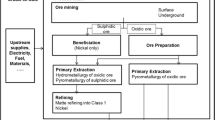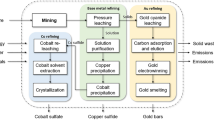Abstract
Purpose
In the booming electric vehicle market, the demand for refined cobalt is showing a blowout growth. China is the largest cobalt-refiner and cobalt-importer in the world. However, the life cycle inventory and potential environmental impact from cobalt refining in China have not been clearly illustrated. This paper builds a comprehensive inventory to support the data needs of downstream users of cobalt sulfate. A “cradle-to-gate” life cycle assessment was conducted to provide theoretical support to stakeholders.
Methods
A life cycle assessment was performed based on ISO 14040 to evaluate the potential environmental impact and recognize the key processes. The system boundary of this study contains four stages of cobalt sulfate production: mining, beneficiation, primary extraction, and refining. Except for the experimental data used in the primary extraction stage, all relevant data are actual operating data. The normalization value was calculated based on the latest released global emission and extraction data.
Results and discussion
Normalization results show that the potential impacts of cobalt refining were mainly concentrated in the fossil depletion and freshwater ecotoxicity categories. The beneficiation stage and the refining stage account for 72% and 26% of the total normalization value, respectively. The beneficiation stage needs to consume a lot of chemicals and energy to increase the cobalt content, due to the low grade of cobalt ore in China. Compared with cobalt concentrate, the use of cobalt-containing waste (e.g., cobalt waste from EV batteries) can ease endpoint impact by up to 73%. With the application of the target electricity structure in 2050, the potential impact of China’s cobalt sulfate production on global warming, fossil depletion, and particulates formation can be reduced by 24%, 22%, and 26%, respectively.
Conclusion
Findings indicate that the chemical inputs and electricity consumption are primary sources of potential environmental impact in China’s cobalt sulfate production. Promoting the development of urban mines can reduce excessive consumption of chemicals and energy in the beneficiation stage. The environmental benefits of transforming the electricity structure and using more renewable energy to reduce dependence on coal-based power in the cobalt refining industry were revealed.






Similar content being viewed by others
References
Ahmadi L, Young SB, Fowler M et al (2017) A cascaded life cycle: reuse of electric vehicle lithium-ion battery packs in energy storage systems. Int J Life Cycle Assess 22:111–124. https://doi.org/10.1007/s11367-015-0959-7
Amarakoon S, Smith J, Segal B (2013) Application of life-cycle assessment to nanoscale technology: lithium-ion batteries for electric vehicles. Available from: http://www.epa.gov/dfe/pubs/projects/lbnp/final-li-ion-battery-lca-report.pdf. (Accessed 4 May 2020)
Bulle C, Margni M, Patouillard L et al (2019) IMPACT World+: a globally regionalized life cycle impact assessment method. Int J Life Cycle Assess 24:1653–1674. https://doi.org/10.1007/s11367-019-01583-0
Cerdas F, Andrew S, Thiede S, Herrmann C (2018) Environmental aspects of the recycling of lithium-ion traction batteries. In: Sustainable production, life cycle engineering and management
Chen Z, Zhang L, Xu Z (2020) Analysis of cobalt flows in mainland China: exploring the potential opportunities for improving resource efficiency and supply security. J Clean Prod 275:122841. https://doi.org/10.1016/j.jclepro.2020.122841
CI (Cobalt institude) (2016) Life cycle inventory and life cycle assessment of refined cobalt - summary report. Available from: https://www.cobaltinstitute.org/life-cycle-assessment.html. (Accessed 8 April 2020)
Ciacci L, Chen W, Passarini F et al (2013) Historical evolution of anthropogenic aluminum stocks and flows in Italy. Resour Conserv Recycl 72:1–8. https://doi.org/10.1016/j.resconrec.2012.12.004
Crenna E, Secchi M, Benini L, Sala S (2019) Global environmental impacts: data sources and methodological choices for calculating normalization factors for LCA. Int J Life Cycle Assess 24:1851–1877. https://doi.org/10.1007/s11367-019-01604-y
Cui X, Hong J, Gao M (2012) Environmental impact assessment of three coal-based electricity generation scenarios in China. Energy 45:952–959. https://doi.org/10.1016/j.energy.2012.06.063
Daigo I, Hashimoto S, Matsuno Y, Adachi Y (2009) Material stocks and flows accounting for copper and copper-based alloys in Japan. Resour Conserv Recycl 53:208–217. https://doi.org/10.1016/j.resconrec.2008.11.010
Deetman S, Pauliuk S, Van Vuuren DP et al (2018) Scenarios for demand growth of metals in electricity generation technologies, cars, and electronic appliances. Environ Sci Technol 52:4950–4959. https://doi.org/10.1021/acs.est.7b05549
Duan J, Ba H, Wang H et al (2018) Flotation test on separation of copper-cobalt sulphide ore in Congo (DRC). Nonferrous Metals Mieral Processing Section. https://doi.org/10.3969/j.issn.1671-9492.2018.05.005
Duan L, Cui Y, Li Q et al (2020) Recycling and direct-regeneration of cathode materials from spent ternary lithium-ion batteries by hydrometallurgy: status quo and developing. Johnson Matthey Technol Rev. https://doi.org/10.1595/205651320x15899814766688
Dunn JB, Gaines L, Kelly JC et al (2015) The significance of Li-ion batteries in electric vehicle life-cycle energy and emissions and recycling’s role in its reduction. Energy Environ Sci 8:158–168. https://doi.org/10.1039/c4ee03029j
European Commission (2020) Cost competitive process for recycling cobalt from end of life Li-ion batteries. Available from: https://cordis.europa.eu/project/id/863431. (Accessed 20 Dec. 2020)
Farjana SH, Huda N, Mahmud MAP (2019) Life cycle assessment of cobalt extraction process. J Sustain Min 18:150–161. https://doi.org/10.1016/j.jsm.2019.03.002
FMPRC (Ministry of Foreign Affairs of the People’s Republic of China) (2019) China’s implementation of the 2030 Agenda for Sustainable Development. Available from: http://www.news.cn/world/zglsycjzbg.pdf. (Accessed 17 April 2020)
Fu X, Beatty DN, Gaustad GG et al (2020) Perspectives on cobalt supply through 2030 in the face of changing demand. Environ Sci Technol 54:2985–2993. https://doi.org/10.1021/acs.est.9b04975
Gulley AL, McCullough EA, Shedd KB (2019) China’s domestic and foreign influence in the global cobalt supply chain. Resour Policy 62:317–323. https://doi.org/10.1016/j.resourpol.2019.03.015
Helmers E, Dietz J, Hartard S (2017) Electric car life cycle assessment based on real-world mileage and the electric conversion scenario. Int J Life Cycle Assess 22:15–30. https://doi.org/10.1007/s11367-015-0934-3
Hong J, Yu Z, Shi W et al (2017) Life cycle environmental and economic assessment of lead refining in China. Int J Life Cycle Assess 22:909–918. https://doi.org/10.1007/s11367-016-1209-3
Hu Y, Poustie M (2018) Urban mining demonstration bases in China: a new approach to the reclamation of resources. Waste Manag 79:689–699. https://doi.org/10.1016/j.wasman.2018.08.032
Huisman J, Habib H, Brechu MG, et al (2017) ProSUM: prospecting secondary raw materials in the urban mine and mining wastes. In: 2016 Electronics Goes Green 2016+, EGG 2016. Institute of Electrical and Electronics Engineers Inc. https://doi.org/10.1109/EGG.2016.7829826
Huijbregts MAJ, Steinmann ZJN, Elshout PMF et al (2017) ReCiPe2016: a harmonised life cycle impact assessment method at midpoint and endpoint level. Int J Life Cycle Assess 22:138–147. https://doi.org/10.1007/s11367-016-1246-y
Hums ME, Cairncross RA, Spatari S (2016) Life-cycle assessment of biodiesel produced from grease trap waste. Environ Sci Technol 50:2718–2726. https://doi.org/10.1021/acs.est.5b02667
ISO 14040 (2006): Environmental management–life cycle assessment–Principles and framework. Int Organ Stand. ISBN 0580489930 Available from: https://www.document-center.com/standards/show/ISO-14040. (Accessed 5 April 2020)
Kallitsis E, Korre A, Kelsall G et al (2020) Environmental life cycle assessment of the production in China of lithium-ion batteries with nickel-cobalt-manganese cathodes utilising novel electrode chemistries. J Clean Prod 254:120067. https://doi.org/10.1016/j.jclepro.2020.120067
Kang J, Senanayake G, Sohn J, Shin SM (2010) Recovery of cobalt sulfate from spent lithium ion batteries by reductive leaching and solvent extraction with Cyanex 272. Hydrometallurgy 100:168–171. https://doi.org/10.1016/j.hydromet.2009.10.010
Kelly JC, Dai Q, Wang M (2019) Gloally regional life cycle analysis of automotive lithium-ion nickel manganese cobalt batteries. Mitig Adapt Strateg Glob Chang. https://doi.org/10.1007/s11027-019-09869-2
Krook J, Baas L (2013) Getting serious about mining the technosphere: a review of recent landfill mining and urban mining research. J Clean Prod 55:1–9. https://doi.org/10.1016/j.jclepro.2013.04.043
Li M, Lu J (2020) Cobalt in lithium-ion batteries. Science 367(6481):979–980. https://doi.org/10.1126/science.aba9168
Liu G, Baniyounes a., Rasul MG, et al (2013) Towards a life cycle sustainability assessment: making informed choices on products. Int J Life Cycle Assess. https://doi.org/10.1007/s11367-012-0482-z
Liu W, Lund H, Mathiesen BV, Zhang X (2011) Potential of renewable energy systems in China. Appl Energy. https://doi.org/10.1016/j.apenergy.2010.07.014
Ma X, Yang D, Zhai Y et al (2019) Cost-combined life cycle assessment of ferronickel production. Int J Life Cycle Assess 24:1840–1850. https://doi.org/10.1007/s11367-019-01600-2
Majeau-Bettez G, Hawkins TR, StrØmman AH (2011) Life cycle environmental assessment of lithium-ion and nickel metal hydride batteries for plug-in hybrid and battery electric vehicles. Environ Sci Technol 45:4548–4554. https://doi.org/10.1021/es103607c
Mathiesen BV, Lund H, Karlsson K (2011) 100% Renewable energy systems, climate mitigation and economic growth. Appl Energy. https://doi.org/10.1016/j.apenergy.2010.03.001
Müller DB, Wang T, Duval B, Graedel TE (2006) Exploring the engine of anthropogenic iron cycles. Proc Natl Acad Sci U S A 103:16111–16116. https://doi.org/10.1073/pnas.0603375103
Nansai K, Nakajima K, Kagawa S et al (2015) Global mining risk footprint of critical metals necessary for low-carbon technologies: the case of neodymium, cobalt, and platinum in Japan. Environ Sci Technol 49:2022–2031. https://doi.org/10.1021/es504255r
NDRC (National Development and Reform Commission) (2018) China Renewable Energy Outlook: Executive summary. Available from: http://boostre.cnrec.org.cn/wp-content/uploads/2018/11/CREO-2018-Summary-EN.pdf. (Accessed 6 July 2020)
NBS (National Bureau of Statistics of China) (2020). Statistics on China’s power generation structure in 2019. Available from: http://data.stats.gov.cn/easyquery.htm?cn=C01. (Accessed 20 July 2020)
ResearchInChina (2018) Market Research Report: Global and China Cobalt Industry Report, 2018–2023. Available from: http://www.researchinchina.com/Htmls/Report/2018/10508.html. (Accessed 17 April 2020)
Pehlken A, Albach S, Vogt T (2017) Is there a resource constraint related to lithium ion batteries in cars? Int J Life Cycle Assess 22:40–53. https://doi.org/10.1007/s11367-015-0925-4
Peters JF, Baumann M, Zimmermann B et al (2017) The environmental impact of Li-Ion batteries and the role of key parameters – a review. Renew Sustain Energy Rev 67:491–506. https://doi.org/10.1016/j.rser.2016.08.039
Prevete B (2019) The EV lithium-ion battery market in China | 2018. https://doi.org/10.13140/RG.2.2.26396.03205
Schmidt T, Buchert M, Schebek L (2016) Investigation of the primary production routes of nickel and cobalt products used for Li-ion batteries. Resour Conserv Recycl 112:107–122. https://doi.org/10.1016/j.resconrec.2016.04.017
Shah V, Collins D, Walker VK et al (2017) Environmental impacts of hybrid and electric vehicles-a review. Int J Life Cycle Assess 22:1127–1142. https://doi.org/10.1179/aes.2001.110.2.75
Shedd KB, McCullough EA, Bleiwas DI (2017) Global trends affecting the supply security of cobalt. Min Eng 69:37–42
Sun X, Hao H, Liu Z et al (2019) Tracing global cobalt flow: 1995–2015. Resour Conserv Recycl 149:45–55. https://doi.org/10.1016/j.resconrec.2019.05.009
van den Brink S, Kleijn R, Sprecher B, Tukker A (2020) Identifying supply risks by mapping the cobalt supply chain. Resour Conserv Recycl 156:104743. https://doi.org/10.1016/j.resconrec.2020.104743
USDI (U.S. Department of the Interior) (2018) Final List of Critical Minerals 2018. Available from: http://www.federalregister.gov/documents/2018/05/18/2018-10667/final-list-of-critical-minerals-2018. (Accessed 17 April 2020)
USGS (U.S. Geological Survey) (2020) Cobalt Data Sheet-Mineral Commodity Summaries 2020. Mineral Commodity Summaries. Available from: https://pubs.usgs.gov/periodicals/mcs2020/mcs2020-cobalt.pdf. (Accessed 20 April 2020)
Wang MM, Zhang CC, Zhang FS (2016) An environmental benign process for cobalt and lithium recovery from spent lithium-ion batteries by mechanochemical approach. Waste Manag 51:239–244. https://doi.org/10.1016/j.wasman.2016.03.006
Wang Y, Ge J (2020) Potential of urban cobalt mines in China: an estimation of dynamic material flow from 2007 to 2016. Resour Conserv Recycl 161:104955. https://doi.org/10.1016/j.resconrec.2020.104955
Wernet G, Bauer C, Steubing B, Reinhard J, Moreno-Ruiz E, Weidema B (2016) The ecoinvent database version 3 (part I): overview and methodology. Int J Life Cycle Assess 21:1218–1230. https://doi.org/10.1007/s11367-016-1087-8
Ye L, Qi C, Hong J, Ma X (2017) Life cycle assessment of polyvinyl chloride production and its recyclability in China. J Clean Prod 142:2965–2972. https://doi.org/10.1016/j.jclepro.2016.10.171
Zackrisson M, Avellán L, Orlenius J (2010) Life cycle assessment of lithium-ion batteries for plug-in hybrid electric vehicles-critical issues. J Clean Prod 18:1519–1529. https://doi.org/10.1016/j.jclepro.2010.06.004
Zeng X, Li J (2015) On the sustainability of cobalt utilization in China. Resour Conserv Recycl 104:12–18. https://doi.org/10.1016/j.resconrec.2015.09.014
Zhang R, Wang G, Shen X et al (2020) Is geothermal heating environmentally superior than coal fired heating in China? Renew Sustain Energy Rev 131:110014. https://doi.org/10.1016/j.rser.2020.110014
Zhou Y, Li J, Wang G et al (2019) Assessing the short-to medium-term supply risks of clean energy minerals for China. J Clean Prod 215:217–225. https://doi.org/10.1016/j.jclepro.2019.01.064
Funding
We gratefully acknowledge financial support from the National Natural Science Foundation of China (Grant Nos. 71671105; 71974113), National Key Research and Development Program of China (Grant Nos. 2017YFF0206702; 2017YFF0211605), Major Basic Research Projects of the Shandong Natural Science Foundation, China (ZR2018ZC2362), and The Fundamental Research Funds of Shandong University, China (2018JC049).
Author information
Authors and Affiliations
Corresponding author
Additional information
Communicated by Andrea J Russell-Vaccari.
Publisher's Note
Springer Nature remains neutral with regard to jurisdictional claims in published maps and institutional affiliations.
Supplementary information
Below is the link to the electronic supplementary material.
Rights and permissions
About this article
Cite this article
Zhang, T., Bai, Y., Shen, X. et al. Cradle-to-gate life cycle assessment of cobalt sulfate production derived from a nickel–copper–cobalt mine in China. Int J Life Cycle Assess 26, 1198–1210 (2021). https://doi.org/10.1007/s11367-021-01925-x
Received:
Accepted:
Published:
Issue Date:
DOI: https://doi.org/10.1007/s11367-021-01925-x




